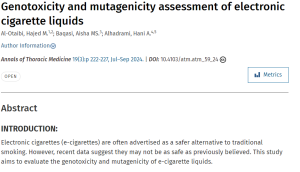Vaping is widely considered a safer alternative to smoking, allowing people to get a nicotine hit without suffering the harms of traditional cigarettes.
But safer doesn’t neccessarily mean safe.
Evidence is now piling up to show the gadgets pose their own dangers, with multiple studies raising the alarm about vaping’s potential risks.
Experts are especially concerned about the meteoric rise of the habit among teens – and even younger children – who have never smoked before.
Fresh e-cigarette health fears were sparked today after an alarming study suggested vaping triggers cell changes which may go on to cause cancer — just like traditional tobacco smoking.
Scientists who examined mouth swabs from smokers and e-cigarette users found similar DNA changes in the cell samples taken from both groups.
It indicated vaping is ‘not as harmless as originally thought’, said researchers from University College London and the University of Innsbruck, Austria.
Experts claimed it added to a growing body of evidence that long-term use of the devices may cause significant damage to health.

Cancer Research UK says there is no good evidence that vaping causes cancer.
Previous studies have also found vapers experienced a similar pattern of changes within their genes as smokers, although the changes are more extensive in people who smoke.
Other studies have highlighted the risk posed by the chemical reactions that occur in the vaping process.
Metal components of the devices which heat the liquid containing the nicotine and flavourings — creating the vapour — can also release of a plume of toxic metals.
These include arsenic, chromium, nickel and lead, known carcinogens.
Studies have suggested exposure to these metals could also contribute to dreaded ‘popcorn lung’ — dangerous inflammation of the respiratory organs which leads to wheezing, coughing and shortness of breath.
Popcorn lung is caused by a build-up of scar tissue in the lungs, which blocks the flow of air.
Although Cancer Research UK denies this and states an additive in e-cig liquids that was linked to the condition was banned in 2016.
In extreme cases, vaping-induced inflammation has even been linked to holes forming in the lung itself.
Inflammation from vaping usually takes a month to form as nanoparticles from the vapour progressively become embedded in lung tissue.
This inflammation also increases the risk of a person suffering respiratory infections, including Covid, experts say.
Some specific chemicals like cinnamaldehyde, diacetyl and acetylpropionyl added to certain vapes and vape liquid flavours provoke stronger responses.
One study found people who vaped for at least six months had high levels of inflammation, mouth wounds and up to a 100-fold increase in oral fungi.
A paper published in the American Journal of Preventive Medicine, which tracked vapers for three years, also found they had a 1.3-times higher risk of developing respiratory disease than people who did not use any tobacco product.
Chemicals contained in vapes can also cause oxidative stress, a type of damage to cells.
In a study, researchers from the University of California, Los Angeles, compared oxidative stress in the lungs of routine cigarette smokers, vapers and people with no history of long term use of tobacco or nicotine devices.
Vaping for only 30 minutes caused oxidative stress levels two to four times higher than baseline levels in those with no history of smoking, they found.
Another danger of vapes, which is exactly the same for cigarettes, is their addictive nature, courtesy of their nicotine content.
Source: Dailymail










